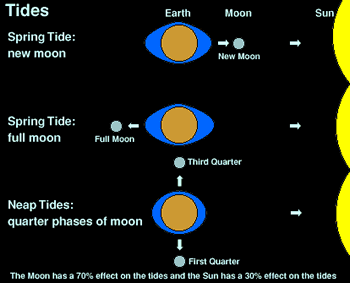

I mage credit: Brocken Inaglory, Creative Commons Attribution Water-breathing animals, also designed to take advantage of both underwater and above water food sources, can scuttle about similarly.įigure 3: Tide pool plants and animals. Air-breathing animals designed to feed in both underwater and above water environments can scurry from inundated to dehydrating pools. The plants pictured here thrive under conditions of regular periods of both dehydration and saltwater inundation. This wide amplitude range for Earth’s tides extends the diversity of Earth’s shoreline creatures.įigure 3 shows a few of the plants and animals uniquely designed for taking advantage of ocean shorelines that experience strong, complex temporal tidal modulation. Some shoreline regions possess a difference between low tide and high tide of only about a meter (3 feet), while the difference between low and high tide in Nova Scotia’s Bay of Fundy can be up to 17 meters (56 feet) in height. Furthermore, because tidal actions manifest a wide range of amplitudes depending on the geography of Earth’s shorelines, the kinds of tide pool networks vary greatly. Such networks of tide pools produce habitats for creatures distinct from those on the land and those in the oceans. Strong, complex temporal modulation of Earth’s ocean tides produces networks of tide pools on the shorelines of Earth’s continents, where different tide pools in the network become isolated from wave action at different times and for different durations. The result is complex, temporally modulated tides. On other days in the Moon’s 29.53-day orbital period about Earth, the difference between low and high tides can be anything in between the differences between neap tide days and spring tide days. On these days, the neap tide days, the difference between low and high tides can be a third to a half the difference between the low and high spring tide days.įigure 2: Neap tides. Here, the tidal force of the Sun on Earth cancels out about half the tidal force of the Moon. Once every 29.53 days, the Sun and Moon line up on opposite sides of Earth (see figure 2). A spring tide where the Moon is at its closest distance to Earth can be up to 0.2 meters (8 inches) higher.įigure 1: Spring tides. This arrangement generates the exceptionally high spring tides. Once every 14.77 days, the Sun and Moon line up with Earth so that their tidal forces on Earth augment one another (see figure 1). The fact that tidal forces exerted by the Sun and Moon are comparable-but not equal-while the periodicities are less comparable, generates resultant tides on Earth’s oceans that exhibit strong, complex temporal modulation (tidal amplitude variation with respect to time). The Sun modulates tides on Earth with a periodicity of 24 hours while the Moon does so with a periodicity of 29.53 days. The Moon’s mass and current distance from Earth is such that it exerts about twice the tidal force on Earth as does the Sun. The Moon orbits close enough to Earth to exert an even stronger tidal force. 1Įarth orbits close enough to the Sun to receive a strong solar tidal force. This role was the subject of a research paper published in the British journal, Proceedings of the Royal Society A. One we did not discuss was how the nearly equal, but not exactly equal, tidal forces that the Sun and Moon exert on Earth play an important role in enhancing the biocomplexity, biodiversity, and biomass of Earth’s life. We not only witnessed a spectacular solar eclipse but also learned in several different ways how the Sun and Moon are exquisitely designed to enable the existence of human beings on Earth.Īt that conference we did not, by any means, exhaust all the known ways the Sun and Moon are designed for advanced life. We held the conference on a site and at the time of a total solar eclipse. In August 2017, Reasons to Believe organized a conference on the fine-tuned design of the Sun and Moon that makes advanced human civilization possible.


 0 kommentar(er)
0 kommentar(er)
